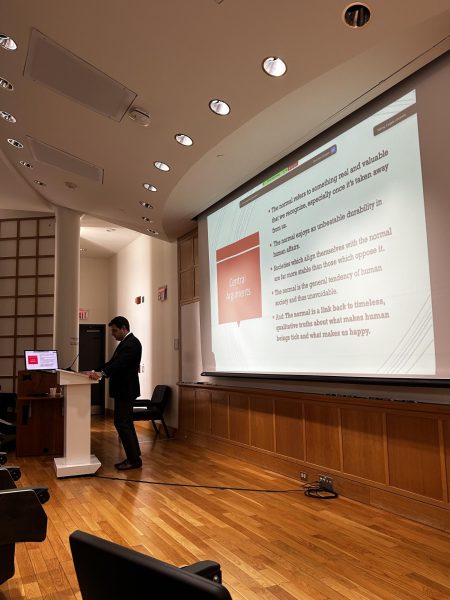VISION Meeting Approaches the Racial Climate on Campus

Recently, a series of planned scenes of public racial intolerance have taken place in the O’Connor Campus Center (Coop), in Frank Dining Hall and on the Persson Hall steps. Unbeknownst to bystanders, the students involved in all three scenes were acting when they engaged in a verbal exchange of racial slurs, but only once did an outside party intervene in the situation.
Due to the lack of a substantial response from the Colgate community during these social experiments, an instance of racial insensitivity at Slices during the Spring 2009 semester and the recent release of the Colgate Campus Life Survey (CCLS), VISION and the Cushman Conversation Series are in the process of holding a three-part discussion series focusing on the main areas of concern identified by the CCLS: the seemingly unsatisfactory social, racial and sexual climates.
The second discussion, which focused on race, was held on Wednesday in the Africana, Latin, Asian and Native American (ALANA) Cultural Center. Although the excellent attendance at the social climate discussion dwarfed the mere nine students who showed up to discuss race relations, VISION Liaison Sophomore Alex Restrepo described the discussion on race relations as being “much more productive.”
“Although we had a wide spectrum of groups represented at the last discussion, despite the numbers this time, we came up with some really innovative ideas,” Restrepo said.
Discussion participants attributed the poor reaction on the part of the bystanders to the planned scenes and the general dissatisfaction with the racial climate as outlined by the CCLS to a phenomenon called the “Colgate Shuffle.”
“People at Colgate are always in such a rush to get from their classes to their meetings to their lectures” one participant said, describing the “shuffle.”
“When everyone goes along through their days doing their own thing, the issue becomes how you can get everyone to slow down and take notice of what and whom is actually around them,” President of Cushman House and Director of the Student Lecture Forum senior Conor Tucker said.
Participants agreed that “the shuffle” is directly related to poor race relations due to the fact that Colgate students are prone to getting wrapped up in their own social networks. Furthermore, once these networks are solidified, it is almost impossible to move outside of them socially.
The entire discussion was founded upon one of the very first comments made by one of the participants that afternoon: the racial climate and the social climate are inextricably linked and therefore will always be parallel.
If social groups are largely assembled by race, finding a solution to the self-segregation and general dissatisfaction with the racial climate “is all about normalizing interactions with people from other groups,” Student Government Association (SGA) President senior Mike Schneider said.
“Because it is not part of the Colgate culture to attend a ‘cultural event’ every week, the solution is to host events where mixing occurs, but not specifically call them cultural events. That would be progress,” Schneider said.
Although participants in the VISION discussion formulated innovative solutions to the reportedly unsatisfactory racial climate on campus, leaders of the discussion attributed the difficulty of creating concrete solutions to these problems to something deeper.
“It all comes down to the issue of leadership,” Tucker said “because the ‘Colgate shuffle’ is even more apparent in school leaders.”
Of the 2,800 students on campus, over 10 percent of them, approximately 258 students, are considered “leaders.” The Colgate leadership style is practically an all-inclusive one, and because so many people are involved, solving a problem affecting the entire campus proves to be a difficult task.
“The over-programming that is clearly present at Colgate is good in terms of being able to choose which lecture or club meeting you want to go to, but it becomes a problem when you are trying to fix a community problem. The campus is just broken into too many fractions,” Tucker said.
Change, concluded the leaders of the event, doesn’t necessarily come from the group leaders themselves, but rather from individuals. If Colgate students are encouraged to take small steps on a personal level, the campus could be in for a significant change in climate.
The third and final discussion in the VISON series will take place on Wednesday, March 3 at 4:15 in the ALANA Center. The Sexual Climate, which includes instances of sexual assault, the hook up culture and issues related to sexual identity, will be the next topic of discussion and is open to all who may be interested.




